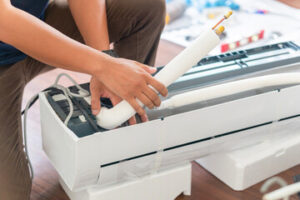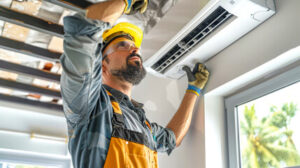While you may be able to troubleshoot some AC issues on your own, it’s always best to leave major repairs to the professionals. This way, you can rest assured that your home will be properly cooled and comfortable.

The anatomy of an air conditioning unit is complex. In order to keep it running efficiently, regular maintenance is required.
Whether you’re an HVAC technician or just starting out in the field, there are some basic tools every service tech needs. These basic tools help ensure that air conditioning maintenance is done correctly and that your customers receive great customer service. The most important tools include a multimeter, which tests electrical voltage, current, and resistance; a leak detector, which finds and fixes refrigerant leaks; and a manometer, which measures system air pressure in ducts and across filters and coils.
Another essential tool is a recip saw, which allows technicians to cut through hard surfaces and pipes. This can save time, reduce the risk of accidents and injuries, and allow for faster repair work. For safety, look for a saw that has a guard to protect the blade and a locking switch to prevent accidental starting.
A handheld thermometer helps technicians measure temperature quickly and accurately. This tool is used to spot air output and refrigerant temperatures in the field, ensuring that the HVAC unit is working properly.
An HVAC service kit should also include a number of supplemental tools, including pipe wrenches and adjustable wrenches for closing valves during installations or repairs; foil tape and duct tape, which help seal ductwork to avoid air leaks; and a vacuum pump to remove moisture and air from refrigerant lines. A set of pliers should be included as well, with needle-nose, long-nose, and linesman pliers all useful for holding or cutting wires.
Finally, a mobile phone is an integral part of any service technician’s arsenal. It lets them capture new work orders and accept payments on the spot, as well as communicate with the office in real time. The mobile device should also have a GPS and a camera, so that the technician can easily navigate to the job site.
Thermal imaging cameras
Thermal imaging, also known as infrared (IR) technology, uses a special camera to detect the thermal energy of an object or scene and turn it into a visual image. The result is a heat map of the object or scene that can reveal hidden problems that may be otherwise invisible to the naked eye. This proactive tool is indispensable for preventive maintenance in a variety of industries.
Unlike regular cameras that use visible light, infrared cameras do not need to be illuminated. Instead, they operate in the long-wavelength infrared spectrum that is emitted by all objects. This means they can work in total darkness, through smoke, and other visual obstructions. In addition, IR cameras can capture temperature measurements and report them as an image on a screen.
When selecting a thermal imaging camera, pay close attention to the key specifications such as resolution, frame rate, and sensitivity. The higher the resolution, the clearer and more detailed an image will be. Additionally, the sensor sensitivity determines how easily an infrared camera can differentiate small differences in temperature and improves overall image quality.
For preventive maintenance in electrical and mechanical inspections, thermal imaging cameras are invaluable tools for detecting overheating components or insulation failures that could lead to equipment failure or fire. They can also help firefighters see through thick smoke and find trapped people more quickly.
Another common application for a thermal imaging camera is in health care, where it can be used to detect changes in body temperature that may indicate the early stages of certain illnesses like heart disease or cancer. The images produced by thermal imaging cameras can also be viewed through a smartphone or tablet, allowing you to access and store the data remotely. Some models, such as the Fluke Ti640 thermal imaging camera, offer IR-Fusion, a technology that combines a visible light image and an infrared image into one display with pixel-for-pixel alignment.
Digital multimeters
The digital multimeter (DMM) is an electronic device that measures two or more electrical values—primarily voltage (volts), current (amperes), and resistance (ohms). A digital display shows results on the meter’s screen. Most meters have a set of test leads and electrical terminals that allow for connections to be made for testing. The meter’s operation is controlled by buttons on the unit and a dial for setting the desired measurement range.
Many digital multimeters have a feature that allows the user to select whether it is measuring AC or DC. This is a safety precaution. The meter should never be connected to a live circuit without first setting it to the proper measurement mode. Most multimeters also have a fuse that prevents damage to the meter when it is accidentally connected to a low-impedance voltage source. Some have test lead fuses that are built into the leads for additional safety.
Unlike their analog counterparts, digital multimeters can provide very accurate readings on a screen. This makes them ideal for use in places where the needle on an analog meter may be difficult to read. However, digital multimeters generally lack the ability to perform tasks that require more specialized equipment, such as measuring temperature with type-K thermocouples and power levels.
Digital multimeters are sensitive devices that must be handled carefully. They can be damaged by drops, especially if they are dropped from a height greater than ten inches. They must be kept in a secure place, and their batteries should be removed when not in use to avoid corrosion at the battery connections. They should be stored in a case to keep them protected from physical damage and moisture.
Anemometers
If you notice a significant increase in your utility bills or your air conditioner isn’t cooling as it should, it may be time to call for an AC repair service. There are other signs of a problem that you should be on the lookout for, too. For example, if you notice an unusual amount of dust accumulating in your vents or ductwork, it could be a sign that your unit isn’t working as it should.
An anemometer is a weather instrument used to measure wind speed, and more advanced models can also be used to determine the direction of the wind flow. This is important for weather forecasting, marine navigation and sports like surfing.
There are several different types of anemometers, including hot wire anemometers and vane anemometers. Hot-wire anemometers have a sensor that measures air velocity by measuring the amount of pressure exerted on it. They are the best choice for measuring low-velocity air. However, they are susceptible to dirt build-up and can be damaged by vibrations.
Another type of anemometer is the vane anemometer, which uses a propeller-like device to measure wind speed. They are able to measure high-velocity air, but they tend to be less accurate at lower speeds. Many models come with a variety of units for measurement (ft/min, m/s, knots) to accommodate a range of applications.
Drainage issues
The air conditioner drain line collects condensation from the evaporator coil and siphons it away from the AC unit. Clogged drain lines are a common problem that can lead to water damage, mold, and system malfunctions. These problems can usually be fixed with a little DIY work, but if the clog is severe or the AC unit is old and inefficient, you’ll need to call an AC repair service for help.
A puddle of water around your outdoor unit is one of the most telltale signs that the drain line is clogged. Water leaking from an air conditioning drain is typically caused by dirt, algae, or mold in the drain line, which prevents the water from flowing freely. These issues are largely preventable with regular maintenance checks and replacement of dirty air filters.
Another sign of a clogged drain line is a musty or moldy smell. The stagnant water in a clogged pipe creates a damp environment that is perfect for the growth of microorganisms like mildew and mold. When they’re exposed to the heat of your home, they release a pungent odor that can be difficult to get rid of.
If you suspect a clog, turn off your air conditioner’s power and remove the cap from the drainage line to access it. Make sure to wear protective gear and shut off your breaker before working with water and electricity. You’ll need a bucket or pan to catch the water in the drain line, a wire brush or pipe cleaner to unclog the drain line, and a cleaning solution like diluted bleach or vinegar to flush the line. You may also want to invest in a wet/dry vacuum or a plumbing snake if you’re having difficulty.
